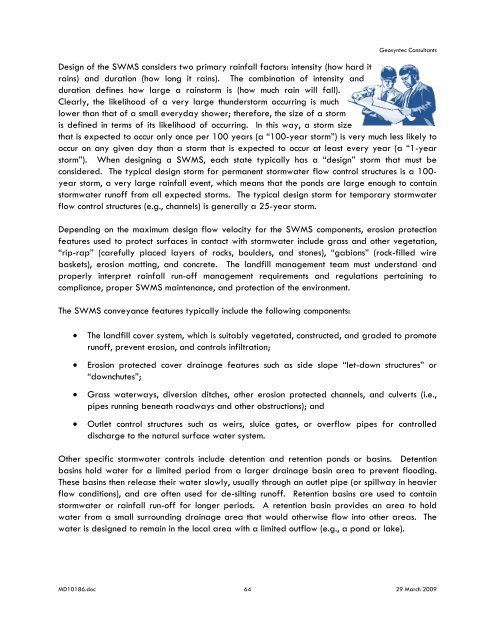AREA A/B ENGINEERING REPORT - Waste Management
AREA A/B ENGINEERING REPORT - Waste Management
AREA A/B ENGINEERING REPORT - Waste Management
Create successful ePaper yourself
Turn your PDF publications into a flip-book with our unique Google optimized e-Paper software.
Geosyntec Consultants<br />
Design of the SWMS considers two primary rainfall factors: intensity (how hard it<br />
rains) and duration (how long it rains). The combination of intensity and<br />
duration defines how large a rainstorm is (how much rain will fall).<br />
Clearly, the likelihood of a very large thunderstorm occurring is much<br />
lower than that of a small everyday shower; therefore, the size of a storm<br />
is defined in terms of its likelihood of occurring. In this way, a storm size<br />
that is expected to occur only once per 100 years (a “100-year storm”) is very much less likely to<br />
occur on any given day than a storm that is expected to occur at least every year (a “1-year<br />
storm”). When designing a SWMS, each state typically has a “design” storm that must be<br />
considered. The typical design storm for permanent stormwater flow control structures is a 100year<br />
storm, a very large rainfall event, which means that the ponds are large enough to contain<br />
stormwater runoff from all expected storms. The typical design storm for temporary stormwater<br />
flow control structures (e.g., channels) is generally a 25-year storm.<br />
Depending on the maximum design flow velocity for the SWMS components, erosion protection<br />
features used to protect surfaces in contact with stormwater include grass and other vegetation,<br />
“rip-rap” (carefully placed layers of rocks, boulders, and stones), “gabions” (rock-filled wire<br />
baskets), erosion matting, and concrete. The landfill management team must understand and<br />
properly interpret rainfall run-off management requirements and regulations pertaining to<br />
compliance, proper SWMS maintenance, and protection of the environment.<br />
The SWMS conveyance features typically include the following components:<br />
• The landfill cover system, which is suitably vegetated, constructed, and graded to promote<br />
runoff, prevent erosion, and controls infiltration;<br />
• Erosion protected cover drainage features such as side slope “let-down structures” or<br />
“downchutes”;<br />
• Grass waterways, diversion ditches, other erosion protected channels, and culverts (i.e.,<br />
pipes running beneath roadways and other obstructions); and<br />
• Outlet control structures such as weirs, sluice gates, or overflow pipes for controlled<br />
discharge to the natural surface water system.<br />
Other specific stormwater controls include detention and retention ponds or basins. Detention<br />
basins hold water for a limited period from a larger drainage basin area to prevent flooding.<br />
These basins then release their water slowly, usually through an outlet pipe (or spillway in heavier<br />
flow conditions), and are often used for de-silting runoff. Retention basins are used to contain<br />
stormwater or rainfall run-off for longer periods. A retention basin provides an area to hold<br />
water from a small surrounding drainage area that would otherwise flow into other areas. The<br />
water is designed to remain in the local area with a limited outflow (e.g., a pond or lake).<br />
MD10186.doc 64 29 March 2009

















